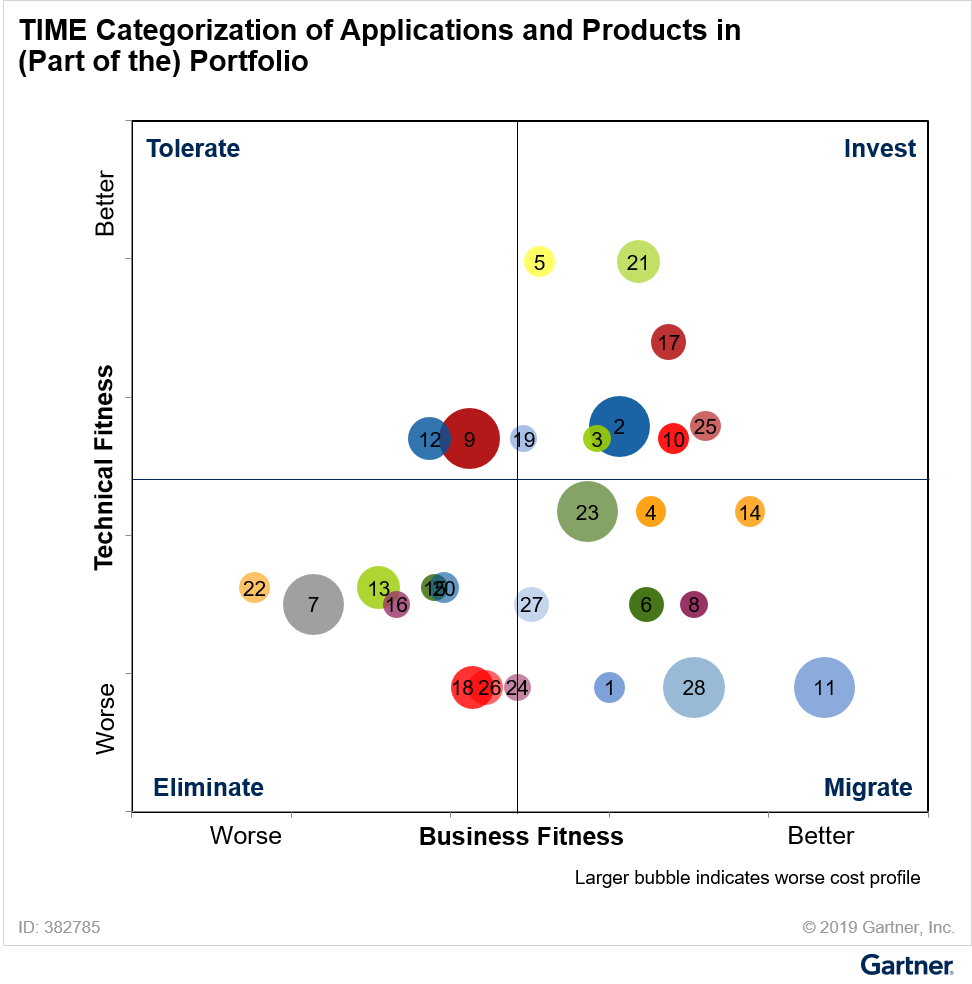How well do you know your application portfolio? Are you confident that your applications are aligned with your business goals? What factors should you consider when prioritizing your IT investments? Do you have a clear understanding of the technical health and financial impact of each application in your tech stack?
Businesses today must regularly assess and revise their application portfolios. This ensures their applications stay relevant and efficient against evolving business and technological landscapes. Such periodic reviews are essential as they help businesses remain competitive by enhancing user satisfaction, reducing operational costs, and minimizing risks. Despite the benefits, the process of aligning applications with business and technical demands is complex and fraught with potential hurdles.
To start this project effectively, I recommend conducting an application assessment. From my professional experience, tools like the Gartner Toolkit for Application Portfolio Business and Technical Fitness Assessment are invaluable. Here’s how you can utilize it to ensure your applications are effectively contributing to your business objectives.
Comprehensive Assessment: Key to Effective Portfolio Management
Industry analysis indicates that successful application portfolio management involves business stakeholders and IT teams. This collaboration ensures the assessments reflect comprehensive business outcomes. Leaders are often challenged with a complex array of applications, where pinpointing crucial enhancements necessitates both business acumen and technical expertise. A holistic review that considers each application's business impact, technical state, and operational costs is fundamental to identifying high-priority improvements.
Assessing Business, Technical, and Cost Fitness
“The fitness review must examine applications from three main dimensions: business fitness, technical fitness and cost fitness. These dimensions determine overall application fitness or health and help the team to identify which applications are in most need of attention. The fitness for a dimension is defined by a number of fitness indicators.”
• Business Fitness: Focuses on how well an application supports business operations, assessing elements like business fit, information quality, timeliness, privacy, and the potential for future contributions.
• Technical Fitness: Evaluates the health of the technical stack that underpins the application, considering factors such as the reliance on skilled experts, maintainability, vendor support, architectural alignment, stability, and security.
• Cost Fitness: Analyzes an application's financial impact, including the costs associated with its operation, maintenance, and potential enhancements.
These assessments help stakeholders pinpoint applications that demand attention and prioritize necessary improvements to align with strategic goals.
For comprehensive insights and methodologies, you can download the detailed Gartner report on application portfolio management: HERE

Example
(Gartner, How to Assess the Fitness of Your Application Portfolio, By Stefan Van Der Zijden, Bill Swanton, Wan Fui Chan, 28 March 2023).
The Strategic Imperative of Legacy System Modernization
In my role at Frends, I've seen firsthand how many of our customers struggle with the limitations of legacy and on-premises systems. This is where our integration platform as a service (iPaaS) comes into play, offering a practical solution to not only migrate these outdated systems but also potentially extend their lifespan by up to a decade.
Across industries, I observe that the legacy systems represent a dual-edged sword: while they are critical to current operations, their outdated nature can hinder agility and growth that are so important for the business future. These systems often demand high maintenance costs and pose integration challenges with newer technologies, emphasizing the need for modernization to secure operational resilience and competitiveness.
For example, as Microsoft BizTalk nears its end-of-life in 2028, organizations relying on this platform face significant decisions regarding system's migration. The move away from BizTalk opens the door to adopting more advanced, hybrid models that blend on-premises and cloud functionalities.
Applying the TIME Model for Strategic Rationalization
“As per Gartner®, applications and software engineering leaders can use the TIME model to illustrate the overall fitness of (part of) the application portfolio and that of individual applications. The business fitness and technical fitness rating will classify each application in one of the following categories:
• Tolerate: The application is in good technical shape but lacking in business support, so IT would tolerate it in the portfolio until the business wanted to invest to improve its business fitness. • Invest: The application is in good shape, so you should invest in it when asked to add features or turn on some new functionality of a packaged application, while also keeping it technically healthy.
• Migrate (or Modernize): The application does what the business wants, but IT is concerned with the age and brittleness of the underlying technology. If the business wants functional improvements, IT should try to address this technical debt simultaneously by migrating the technical stack or the packaged application to current, supported technology.
• Eliminate (or Replace): These applications may be in such bad shape it is not worth investing in them. If they are not needed or the functionality is now available in a better application, they could be eliminated. If the functionality is still needed, they might better be replaced.”
This categorization facilitates a collaborative planning process, ensuring that improvements are prioritized according to their potential impact on business goals.
Conclusion: Empowering Business Through Strategic Application Management
As someone who has navigated these waters, my advice is to not underestimate the power of a well-managed application portfolio. It’s about keeping up with technology and strategically positioning your business for the future.
Regular assessments and the willingness to modernize are key. Make use of comprehensive tools to get a clear picture of where each application stands, and make informed decisions that drive your business forward.
Effective application portfolio management is crucial for businesses aiming to thrive in a digital environment. By regularly updating their application portfolios through strategic assessments and embracing modernization initiatives for legacy systems, organizations can enhance their agility and operational effectiveness. Integrating a broad range of stakeholder inputs into the decision-making process aligns IT investments with business strategies and supports sustainable growth.
Utilizing tools like Gartner Toolkit for Application Portfolio Business and Technical Fitness Assessment from “How to Assess the Fitness of Your Application Portfolio” report can greatly enhance the evaluation process. These tools offer a structured way to measure each application's business value, technical adequacy, and cost efficiency, guiding decision-making, and ongoing portfolio optimization.
Remember, every step you take in refining your application portfolio is a step towards greater innovation and market responsiveness.
Gartner, How to Assess the Fitness of Your Application Portfolio, By Stefan Van Der Zijden, Bill Swanton, Wan Fui Chan, 28 March 2023
GARTNER is a registered trademark and service mark of Gartner, Inc. and/or its affiliates in the U.S. and internationally and is used herein with permission. All rights reserved.

